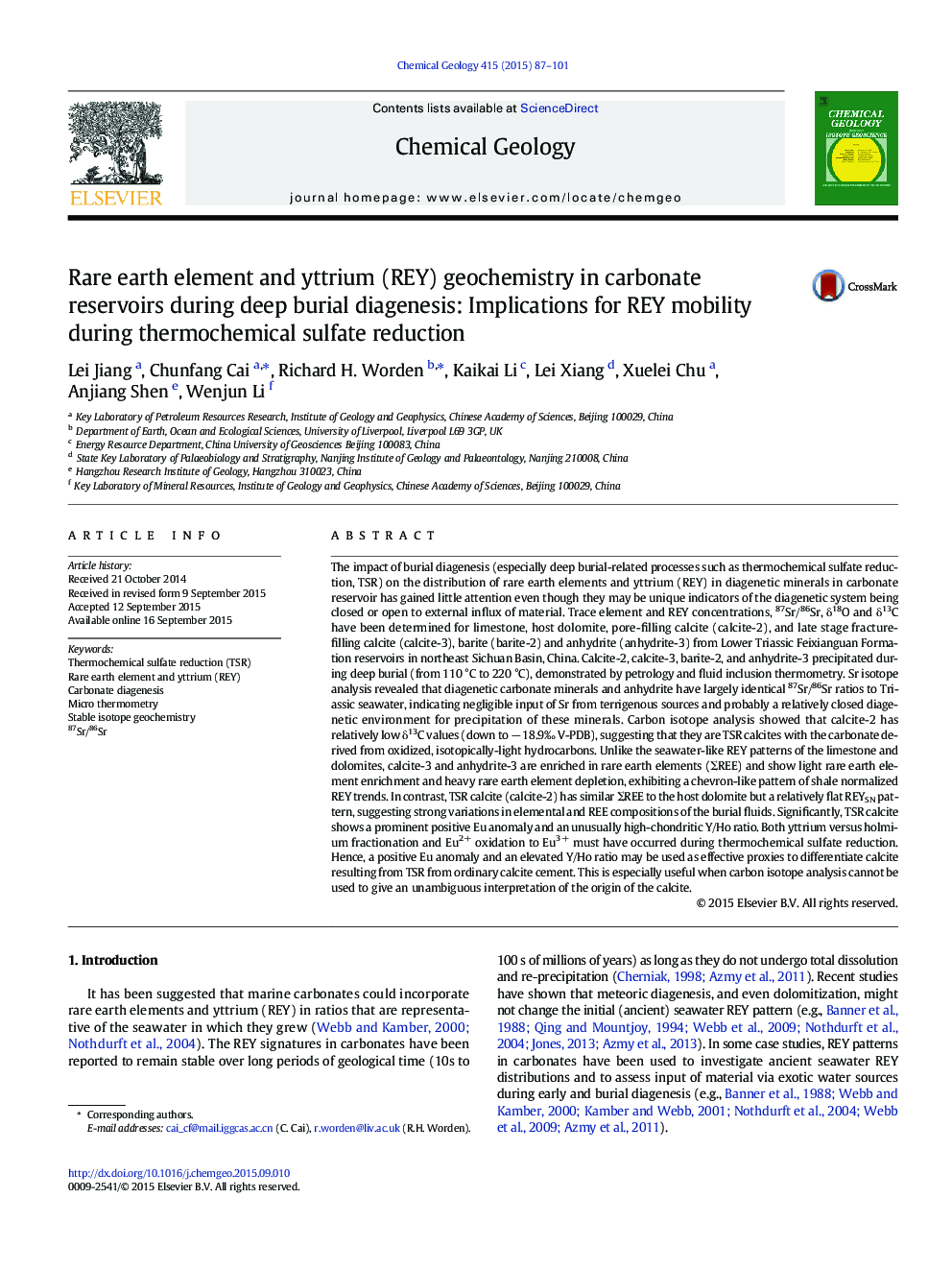| کد مقاله | کد نشریه | سال انتشار | مقاله انگلیسی | نسخه تمام متن |
|---|---|---|---|---|
| 6436226 | 1637559 | 2015 | 15 صفحه PDF | دانلود رایگان |

- A relatively closed diagenetic environment is indicated by87Sr/86Sr ratios.
- TSR calcite shows a prominent positive Eu anomaly and super-high-chondritic Y/Ho ratio.
- A new proxy to help indicate TSR calcite is proposed.
The impact of burial diagenesis (especially deep burial-related processes such as thermochemical sulfate reduction, TSR) on the distribution of rare earth elements and yttrium (REY) in diagenetic minerals in carbonate reservoir has gained little attention even though they may be unique indicators of the diagenetic system being closed or open to external influx of material. Trace element and REY concentrations, 87Sr/86Sr, δ18O and δ13C have been determined for limestone, host dolomite, pore-filling calcite (calcite-2), and late stage fracture-filling calcite (calcite-3), barite (barite-2) and anhydrite (anhydrite-3) from Lower Triassic Feixianguan Formation reservoirs in northeast Sichuan Basin, China. Calcite-2, calcite-3, barite-2, and anhydrite-3 precipitated during deep burial (from 110 °C to 220 °C), demonstrated by petrology and fluid inclusion thermometry. Sr isotope analysis revealed that diagenetic carbonate minerals and anhydrite have largely identical 87Sr/86Sr ratios to Triassic seawater, indicating negligible input of Sr from terrigenous sources and probably a relatively closed diagenetic environment for precipitation of these minerals. Carbon isotope analysis showed that calcite-2 has relatively low δ13C values (down to â 18.9â° V-PDB), suggesting that they are TSR calcites with the carbonate derived from oxidized, isotopically-light hydrocarbons. Unlike the seawater-like REY patterns of the limestone and dolomites, calcite-3 and anhydrite-3 are enriched in rare earth elements (ΣREE) and show light rare earth element enrichment and heavy rare earth element depletion, exhibiting a chevron-like pattern of shale normalized REY trends. In contrast, TSR calcite (calcite-2) has similar ΣREE to the host dolomite but a relatively flat REYSN pattern, suggesting strong variations in elemental and REE compositions of the burial fluids. Significantly, TSR calcite shows a prominent positive Eu anomaly and an unusually high-chondritic Y/Ho ratio. Both yttrium versus holmium fractionation and Eu2 + oxidation to Eu3 + must have occurred during thermochemical sulfate reduction. Hence, a positive Eu anomaly and an elevated Y/Ho ratio may be used as effective proxies to differentiate calcite resulting from TSR from ordinary calcite cement. This is especially useful when carbon isotope analysis cannot be used to give an unambiguous interpretation of the origin of the calcite.
1) Different from dolomite and anhydrite, pore-filling TSR calcites-2 with low δ13C values (down to â 19â°) and high homogenization temperatures (from 115 °C to 220 °C) show positive Eu anomalies and an elevated super-high Y/Ho ratios, and thus the REY signatures are concluded to be used as a new effective proxy to help identify TSR calcite.
Journal: Chemical Geology - Volume 415, 15 November 2015, Pages 87-101